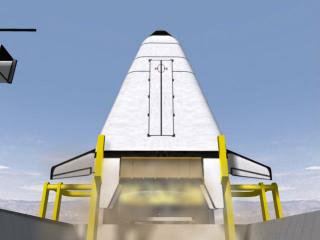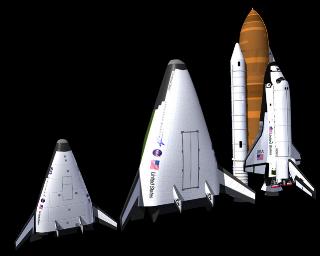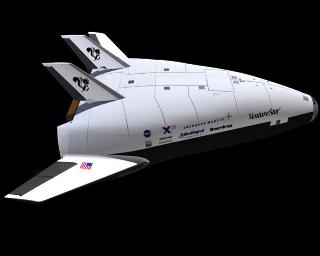 The
X-33.
The
X-33.
 What
is VentureStar®?
What
is VentureStar®?
VentureStar® is envisioned to be the next-generation space delivery system of the 21st century. VentureStar® will revolutionize space transportation by delivering a wide range of payloads to Earth orbit more reliably and less expensively than any of today's launch vehicles. After the first few flights have demonstrated its capability, VentureStar® could also carry crew to the International Space Station and other orbiting destinations. As a fully reusable, single-stage-to-orbit vehicle, VentureStar® incorporates state-of-the-art technology and builds on lessons learned from older launch vehicles. By dramatically reducing the cost and improving the reliability of space transportation, VentureStar® will open the vast frontier of space to a torrent of innovation and entrepreneurship, ultimately leading to an improved quality of life for everyone on Earth. In order to prove that This space craft is viable a prototype or demonstrator vehicle called the X-33 will be built and tested.
 The
X-33.
The
X-33.
The X-33 is an advanced technology demonstrator vehicle with a mission to validate new technologies and reduce risk for the construction of VentureStar®. As a proof-of-concept vehicle, X-33 is one-half the size, one-ninth the weight, and one-fourth the cost of the full-scale VentureStar®.
Through a series of test flights scheduled to begin in the summer of 1999, the X-33 will test the advanced technologies and operations concepts of VentureStar®. Unlike the VentureStar®, X-33 will not reach orbit and will not carry a payload. It will fly suborbital trajectories specifically designed to validate advanced technologies critical to the success of VentureStar®. These flights will test the thermal protection system, aerodynamic characteristics in all flight regimes, autonomous flight capability, as well as other technologies and operational concepts. For more information about flight test objectives. The X-33 will test the application of a fully resuable launch vehicle with a single stage to orbit capability.
"Single-stage-to-orbit" means that VentureStar® does not drop tanks and rocket boosters along its flight path like today's launch vehicles. Fully reusable means VentureStar® will operate more like an airplane. Between flights VentureStar® simply undergoes inspection, refueling, and reloading. There are no components to remanufacture and reassemble. By reusing the entire vehicle, VentureStar® will have a dramatically lower cost of operations, thereby offering space transportation services at up to one-tenth of today's cost. One of the new technologies that will be used in VentureStar® will be the linear aerospke engine.
 The
Linear aerospike engine.
The
Linear aerospike engine.
The linear aerospike engine was initially designed and tested for use on the Space Shuttle in the 1970s. However, at that time, officials decided to develop another design, known today as the "Space Shuttle Main Engine." The aerospike engine design was basically shelved until 1995 when it was proposed for the Lockheed Martin Skunk Works concept for NASA's X-33.
The linear aerospike engine has several performance benefits over today's conventional rocket engines. First, it is lighter because it eliminates the use of a heavy bell nozzle and associated steering systems and because it can be more efficiently integrated with the lifting body vehicle. Additionally, the aerospike design allows it to automatically adjust to changing atmospheric conditions as the vehicle climbs to orbit, enhancing its efficiency throughout ascent. Another benefit is that with multiple combustion chambers on each engine, it is much more fail-safe than conventional single combustion chamber engines.
VentureStar® will reach the speed of approximately 17,500 mph or greater than Mach 25 to reach Earth orbit. This is the speed required for any space vehicle to stay in orbit. Current plans call for the first flight of the VentureStar® in 2004. The first few flights will be "development" flights to test the system. Operational service to deliver commercial and government satellites will begin in mid-2004. The present plan is to build two full-scale VentureStar® vehicles initially. As the market for them expands more of them will be built.
Once the International Space Station becomes operational, a whole new era of space research will begin because we will have a permanent laboratory in orbit. The microgravity research conducted today on the Space Shuttle will be performed on the much more spacious and capable space station. At that point what will be most needed is cheap, reliable transportation to and from orbit. VentureStar® will be able to serve as the transportation backbone to this and any other orbital facility.
 Capabilities
of VentureStar®
Capabilities
of VentureStar®
Although the design of VentureStar® won't be final until after the X-33 test flights in 1999, the current VentureStar® design includes a payload bay of approximately 50 feet long by 15 feet wide by 15 feet deep (15.2 m by 4.6 m by 4.6 m), large enough to carry the largest telecommunications satellites. Payload mass-to-orbit will vary depending on the destination. The current target for VentureStar® is to carry 56,000 pounds to low Earth orbit (LEO), 25,000 pounds to the International Space Station, and 18,000 pounds to geosynchronous transfer orbit (GTO). These capabilities are roughly equivalent to those of the Space Shuttle.
 The
X-33 will take off from Edwards Air Force Base in southern California.
The current test program calls for the first five flights to land at Michael
Army Air Field in Utah and the next two flights will land at Malmstrom
Air Force Base, near Great Falls, Montana. After this, there may be up
to eight more test flights to improve our understanding of various aspects
of vehicle and technology performance. The test objectives on these flights
will be determined after the initial flights have been completed.
The
X-33 will take off from Edwards Air Force Base in southern California.
The current test program calls for the first five flights to land at Michael
Army Air Field in Utah and the next two flights will land at Malmstrom
Air Force Base, near Great Falls, Montana. After this, there may be up
to eight more test flights to improve our understanding of various aspects
of vehicle and technology performance. The test objectives on these flights
will be determined after the initial flights have been completed.
For more information on VentureStar® and the X-33 visit their website at: www.venturestar.com.
The Future Astronauts of America Foundation
Title
'We
help launch the future' slogan and The Future Astronauts of America
Foundation
Logo are intellectual property
of The Future Astronauts of America Foundation.